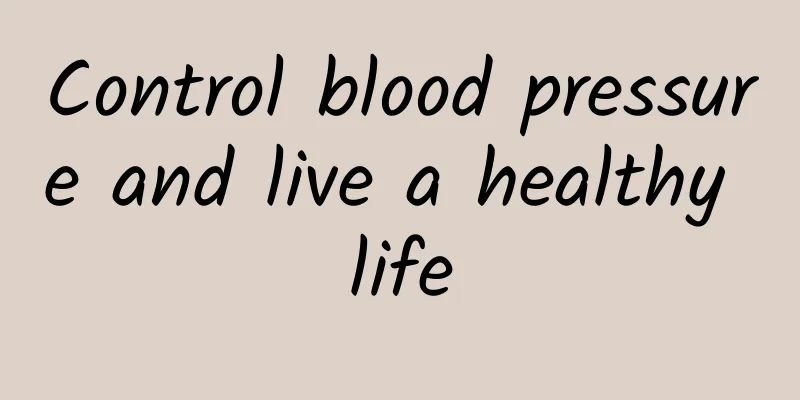Control blood pressure and live a healthy life

|
Control blood pressure and live a healthy life Hypertension is a common cardiovascular disease in clinical practice and a risk factor for coronary heart disease, stroke and other diseases. Currently, the number of people suffering from hypertension worldwide has reached 1.28 billion. There are about 245 million hypertensive patients in my country, with a prevalence of 27.9% for those over 18 years old and about 90% for those 80 years old or older. However, the control rate of hypertension is only 16.8%. Hypertension can lead to cardiac hypertrophy, heart failure, cerebral hemorrhage, cerebral infarction and uremia, which seriously affect the patient's physical health and quality of life and consume huge medical resources. Therefore, early identification of hypertension, standardized treatment and control of blood pressure are a strong guarantee for a healthy life. 1. Diagnosis and clinical manifestations of hypertension Blood pressure refers to the lateral pressure of blood on the blood vessel wall when blood flows in the blood vessels, including systolic pressure and diastolic pressure. Normal systolic pressure is less than 120mmHg, and diastolic pressure is less than 80mmHg. Hypertension refers to systolic blood pressure ≥140 and/or diastolic blood pressure ≥90mmHg in the clinic for three different days in an adult without the use of antihypertensive drugs. The clinical manifestations of hypertension lack specificity, and often there are no symptoms or the symptoms are atypical, including dizziness, headache, chest tightness, palpitations, tinnitus, etc. When blood pressure rises sharply in a short period of time and a hypertensive emergency occurs, it will seriously harm the heart, kidneys, brain and other organs, and the patient will show symptoms such as difficulty breathing, chest pain, nausea, vomiting and changes in consciousness. 2. Accurate measurement of blood pressure Blood pressure measurement is an effective means to assess blood pressure levels, diagnose hypertension and monitor the effect of blood pressure control. Blood pressure measurement mainly includes office blood pressure measurement and out-of-office blood pressure measurement. Office blood pressure is measured by medical staff under standard conditions according to unified standards. It is currently a common method for diagnosing hypertension and grading blood pressure levels. The patient rests for at least 5 minutes and uses an electronic or mercury sphygmomanometer to measure the brachial artery blood pressure in the sitting position. Generally, the blood pressure is measured 2 to 3 times and the average value is taken. Out-of-office blood pressure measurement includes home blood pressure monitoring and dynamic blood pressure monitoring. Home blood pressure monitoring can help identify white coat hypertension and concealed hypertension and is one of the effective methods for long-term follow-up. For patients with newly diagnosed hypertension or patients with unstable blood pressure, it is recommended to measure blood pressure at home every morning and evening, measure 2 to 3 times each time, take the average value, measure continuously for 7 days, and record in detail. The number of measurements can be appropriately reduced after blood pressure stabilizes. When taking oral antihypertensive drugs, blood pressure should be measured before taking the medicine and before meals. Avoid drinking hot water and strenuous exercise 30 minutes before measuring blood pressure, empty the bladder, relax and avoid tension. Dynamic blood pressure monitoring is an indirect non-invasive measurement method that is used continuously for 24 hours. It can reflect the patient's blood pressure changes during the day and night and the trend of changes. It can effectively identify white coat hypertension, concealed hypertension and diagnose simple nocturnal hypertension. During dynamic blood pressure monitoring, it is recommended to maintain normal activities, avoid bathing, and try to stay in a supine position when sleeping. 3. Treatment of hypertension The goal of hypertension treatment is to reduce damage to important organs such as the heart, brain, and kidneys, the occurrence of vascular complications, and reduce mortality. Appropriate treatment plans should be developed based on cardiovascular and cerebrovascular risk factors and target organ damage. First, blood pressure should be lowered by improving the patient's lifestyle, including a low-salt diet with a daily sodium intake of less than 6 grams. When cooking, use less salt, soy sauce, chicken essence, hot sauce, etc., and eat less pickled vegetables, bacon, cured meat, salted fish and other high-salt foods. Eat a reasonable diet, increase potassium-rich fresh fruits and vegetables, eat whole grains, soybeans and nuts, control high-calorie foods, and lose weight. Quit smoking and drinking. If you have difficulty quitting drinking, you should reduce the amount of alcohol you drink or drink a small amount of low-alcohol wine. Increase exercise and maintain a balanced mentality to reduce mental stress. Get enough sleep, have a regular life, and avoid fatigue and emotional stress. If improving your lifestyle still does not achieve your treatment goals, you should seek medical attention promptly and take antihypertensive drugs for standardized treatment under the guidance of a doctor. References [1] Lou Ying, Ma Wenjun, Wang Zijun, et al. Proposal for clinical practice guidelines for hypertension in China[J]. Chinese Journal of Cardiology, 2022, 50(7): 671-675. [2] Hypertension Branch of Chinese Geriatrics Society, National Clinical Research Center for Geriatric Diseases, and Chinese Alliance for Prevention and Treatment of Cardiovascular Diseases in the Elderly. Guidelines for the Management of Hypertension in the Elderly in China 2019[J]. Chinese Journal of Cardiology, 2019, 24(1): 1-23. |
<<: Does frequent anger during pregnancy have any effect on the fetus?
Recommend
How long should I wait before going back to work after a miscarriage?
Many women do not pay attention to rest or nutrit...
Picture of pimple on female urethra
The pimples on the urethral opening of women may ...
What medicine should women use to wash itchy below
Itching in the lower body is an embarrassing thin...
How many months of pregnancy can you feel fetal movement
For pregnant mothers, feeling the fetal movement ...
What is the cause of gynecological inflammation?
Gynecological inflammation has now become a commo...
When is the latest time to take birth control pills?
Common emergency contraception generally refers t...
[Healthy Life] Tianjin pediatric experts remind: If your child has this condition, you should seek medical attention immediately!
This year Compared with previous years, the influ...
What are the effective ways to make your breasts bigger?
In today's society, many women are more conce...
Why do pregnant women have filiform warts?
Filiform warts are a unique type of common warts,...
What is the inflammation of vaginal odor?
Many female friends have recently experienced vag...
Five types of fat-burning tea are effective. Are you drinking them right?
Many female friends know that drinking tea can no...
Can I cut my nails after having a miscarriage?
Miscarriage is something that happens to many wom...
Eight traditional Chinese medicine recipes for treating vaginitis
Vaginitis is one of the common gynecological dise...
There is a line on the pregnant belly that can tell the gender of the baby
There is a line on the pregnant belly that can te...
What are the benefits of estrogen supplementation for women?
Now many of my female colleagues over 35 have sta...









